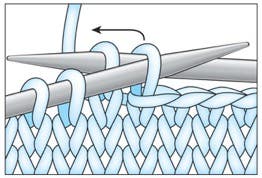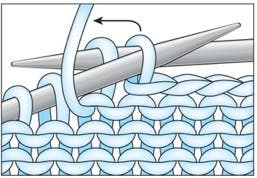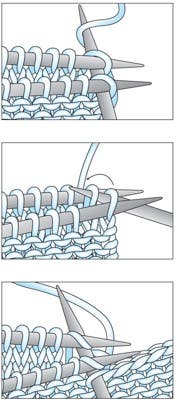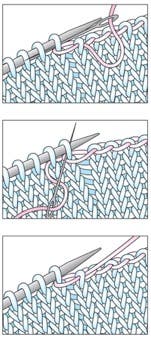How to Bind Off
To finish your knitting project, you will likely need to bind off, sometimes abbreviated BO. Binding off is a way of removing the loops from your knitting needle and giving your piece a nice edge. Just like with cast-ons, there are many types of bind-offs you can choose from to achieve the look and feel that you would like.
Different bind-offs create different edges on your projects. We’ll introduce you to a handful of the options here. The most common are simple bind-offs knitwise or purlwise. We’ll also show you the very sturdy three-needle bind-off and the most basic of the sewn bind-offs. You can also bind off in a rib pattern, which is preferred if your pattern ends in ribbing to keep the stretchy edge.
There are additional bind-offs that you can learn (not outlined here) that can give your piece a very professional look, including forms of tubular and sewn bind-offs. These more complex bind-offs are elastic and look great on garments and accessories.
Knit Bind-Off (Bind Off Knitwise)
This bind-off and the purlwise one shown next are chained bind-offs. They produce V-shaped stitches along the top of the fabric. They are worked by pulling stitches one over the other to secure the edge. Working this edge will create a smooth finish on the top of your stitches.
The edge is not very elastic. If you find that you bind off too tight, try using a right-hand needle that is one size larger than what you knitted with.
Knit the first two stitches on the left-hand knitting needle. *Insert the tip of the left-hand knitting needle into the first stitch worked on the right-hand knitting needle, then lift the first stitch up and over the second stitch on the right-hand knitting needle and then off the needle. You have now bound off one stitch.
Knit the next stitch and repeat from *. When one stitch remains on the right-hand knitting needle, cut the yarn and draw the tail through the last stitch to fasten off.


Purl Bind-Off (Bind Off Purlwise)
This is another chained bind-off that creates V-shaped stitches along the top of the fabric. It is worked by pulling stitches one over the other to secure the edge. This bind-off leaves a purl bump along the top edge of your fabric. Use this when binding off a predominantly purl-based fabric or to give the appearance of a little ridge along your work.
The edge created with this bind-off is not very elastic. If you find that you bind off too tight, try using a right-hand needle that is one size larger than what you knitted with.
Purl the first two stitches on the left-hand knitting needle. *Insert the tip of the left-hand knitting needle into the first stitch worked on the right-hand knitting needle. With the left-hand knitting needle, lift the first stitch up and over the second stitch and off the right-hand knitting needle.
Purl the next stitch and repeat from *. When one stitch remains on the right-hand knitting needle, cut the yarn and draw the tail through the last stitch to fasten off.


Bind off in Ribbing
If your fabric ends in a ribbing pattern, you will want to bind off in pattern. That means you will use a combination of binding off knitwise and purlwise depending on the next stitch to be bound off. This will produce a slightly more elastic edge that will blend in nicely with your ribbing pattern.
Three-Needle Bind-Off
This bind-off is an easy way to join two pieces of fabric that are still on the knitting needles. To work this bind-off, you will need a third needle. It is another chained bind-off as you are still pulling stitches up and over each other and producing a series of V stitches along the fabric. This bind-off produces a visible seam where the two fabrics are brought together. It is used often to seam shoulders because it is very sturdy and doesn’t have much elasticity.
Be sure your two pieces of fabric have the same number of stitches. If you bind off too tight, use a third needle that is one size large than the needles in the fabric.
Hold the two knitting needles that have the stitches to be joined with tips facing to the right and with the right sides of the fabric facing each other. With a third knitting needle, knit together a stitch from the front knitting needle with one from the back knitting needle. Repeat knitting a stitch from the front knitting needle with one from the back knitting needle. Then pass the first stitch on the right-hand knitting needle up and over the second stitch, then off the needle.
Continue knitting a front and back pair of stitches together, then binding one off, until all stitches have been joined and bound off.


Sewn Bind-Off
This is a form of grafting the edge of your work. It is a very stretchy bind-off with an edge similar to the long-tail cast-on edge. You will use a tapestry needle to sew the stitches together in a particular way. This edge is not easy to undo. You will have to unpick stitch by stitch if you make a mistake. What is outlined below is just one version of a sewn bind-off.
Cut the working yarn, leaving a tail about three to four times the length of the row you are binding off. Thread the end of the yarn through the eye of a tapestry needle. *Insert the tapestry needle through the first two stitches on the left-hand knitting needle as if to purl. Pull the yarn through but do not remove the stitches from the needle. Insert the tapestry needle through the first stitch on the left-hand knitting needle again, this time as if to knit. Pull the yarn through and slip the stitch off the needle. Repeat from * until all stitches have been bound off.


